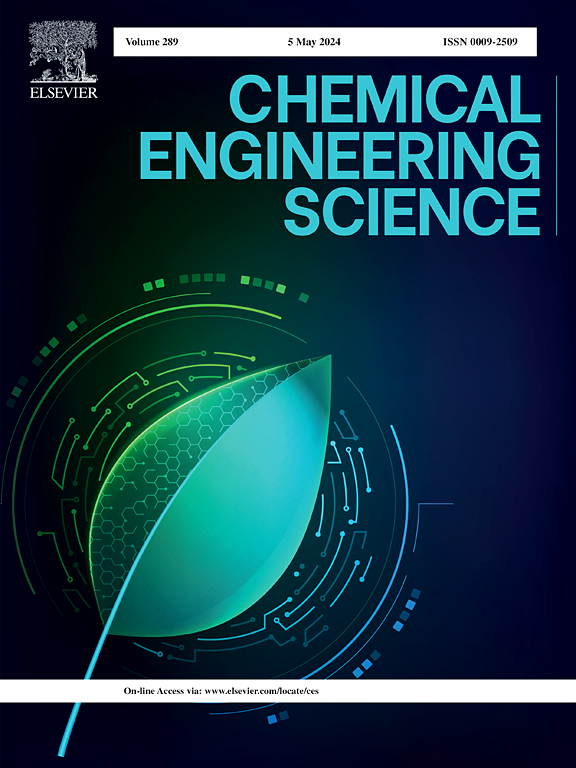Predicted C–N coupling performance of lateral heterostructure interfaces between two types of layered materials for electrochemical synthesis of acetamide and Ammonia via reduction of CO2 and N2
IF 4.3
2区 工程技术
Q2 ENGINEERING, CHEMICAL
引用次数: 0
Abstract
Currently, carbon dioxide reduction (CO2RR) can convert CO2 into many high-value hydrocarbon chemicals via electrochemical processes, contributing to achieving energy conservation and emission reduction. Importantly, this method also guides the electrocatalytic synthesis of organonitrogen chemicals via C–C and C–N coupling, such as acetamide synthesis during the coelectroreduction of CO2 and N2. Herein, we utilized density functional theory calculations to predict the C–N coupling performance of *CCO and NH3 for acetamide synthesis on lateral heterostructure (LHS) interfaces of two types of layered materials: Type-A includes NbS2/MoS2, NbS2/TaS2, NbS2/WS2, MoS2/TaS2, and TaS2/WS2; Type-B contains LHS NbS2/AlN, NbS2/GaN, NbS2/ZnO, MoS2/AlN, MoS2/GaN, MoS2/ZnO, TaS2/AlN, TaS2/GaN, TaS2/ZnO, and WS2/AlN, WS2/GaN, WS2/ZnO. However, achieving simultaneous C–C coupling and C–N coupling remains a great challenge in designing catalysts. To address this, we systemically investigated these LHS catalysts, evaluating factors such as adsorption stability, electroconductivity, catalytic activity, selectivity, and electronic properties. Our findings suggest that MoS2/WS2 and NbS2/ZnO may be potential catalysts, facilitating acetamide synthesis from CO2 and N2 reduction with low limiting potentials of − 1.11 and − 0.97 V, respectively. The reaction pathway of CO2RR involves the formation of CO, C–C coupling via keto − enol tautomerism to form ketene (*CCO), N2 reduction, and C–N coupling between NH3 and *CCO to produce *CC(OH)NH2, finally resulting in acetamide production. Most of these LHS junction catalysts exhibit metallic and semiconductor electronic states, except for MoS2/GaN, which possesses a large band gap of up to 3.73 eV. Furthermore, our analysis indicates that NbS2/AlN, NbS2/GaN, TaS2/ZnO, WS2/AlN, and WS2/ZnO effectively suppress competing byproducts, ensuring the formation of *CCO and promoting nucleophilic reactions leading to *CC(OH)NH2 during *CC(OH)NH2. This strategic approach enables the synthesis of organonitrogen chemicals via C–N coupling in the coreduction of CO2 and NOx, expanding the scope of hydrocarbon products derived from CO2RR, the LHS catalysts identified in this study may be employed to form amide chemicals.
预测了两种层状材料间横向异质结构界面通过还原CO2和N2电化学合成乙酰胺和氨的C-N耦合性能
目前,二氧化碳还原(CO2RR)可以通过电化学过程将二氧化碳转化为许多高价值的碳氢化合物,有助于实现节能减排。重要的是,该方法还指导了通过C-C和C-N偶联的电催化合成有机氮化学品,例如CO2和N2共电还原过程中合成乙酰胺。本文利用密度泛函理论计算预测了*CCO和NH3在两种层状材料横向异质结构(LHS)界面上合成乙酰胺的C-N耦合性能:a类材料包括NbS2/MoS2、NbS2/TaS2、NbS2/WS2、MoS2/TaS2和TaS2/WS2;b型LHS包括NbS2/AlN、NbS2/GaN、NbS2/ZnO、MoS2/AlN、MoS2/GaN、MoS2/ZnO、TaS2/AlN、TaS2/GaN、TaS2/ZnO和WS2/AlN、WS2/GaN、WS2/ZnO。然而,同时实现C-C和C-N的偶联仍然是催化剂设计中的一大挑战。为了解决这个问题,我们系统地研究了这些LHS催化剂,评估了吸附稳定性、电导率、催化活性、选择性和电子性能等因素。我们的研究结果表明,MoS2/WS2和NbS2/ZnO可能是潜在的催化剂,促进CO2和N2还原合成乙酰胺,其下限电位分别为 − 1.11和 − 0.97 V。CO2RR的反应途径包括CO的形成,通过酮 − 烯醇互变异构作用形成烯酮(*CCO)的C-C偶联,N2还原,NH3与*CCO之间的C-N偶联产生*CC(OH)NH2,最终产生乙酰胺。除了MoS2/GaN具有高达3.73 eV的大带隙外,大多数LHS结催化剂都具有金属和半导体电子态。此外,我们的分析表明,NbS2/AlN、NbS2/GaN、TaS2/ZnO、WS2/AlN和WS2/ZnO有效抑制了竞争副产物,确保了*CCO的形成,并促进了在*CC(OH)NH2过程中导致*CC(OH)NH2的亲核反应。这一策略方法使CO2和NOx的共还原过程中通过C-N偶联合成有机氮化学物质成为可能,扩大了CO2RR衍生烃产品的范围,本研究中鉴定的LHS催化剂可用于合成酰胺类化学物质。
本文章由计算机程序翻译,如有差异,请以英文原文为准。
求助全文
约1分钟内获得全文
求助全文
来源期刊

Chemical Engineering Science
工程技术-工程:化工
CiteScore
7.50
自引率
8.50%
发文量
1025
审稿时长
50 days
期刊介绍:
Chemical engineering enables the transformation of natural resources and energy into useful products for society. It draws on and applies natural sciences, mathematics and economics, and has developed fundamental engineering science that underpins the discipline.
Chemical Engineering Science (CES) has been publishing papers on the fundamentals of chemical engineering since 1951. CES is the platform where the most significant advances in the discipline have ever since been published. Chemical Engineering Science has accompanied and sustained chemical engineering through its development into the vibrant and broad scientific discipline it is today.
 求助内容:
求助内容: 应助结果提醒方式:
应助结果提醒方式:


